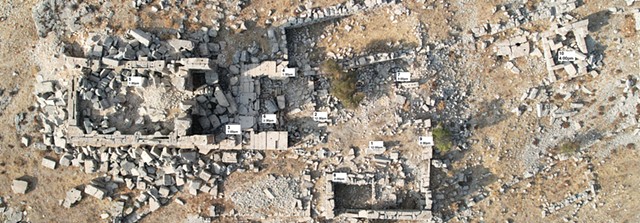Presences From The Sun
Presences From The Sun
Part of Scratch the surface, touch the sun
Public Art Commissioned by TAP
Hosn Niha, Beqaa, Lebanon
October 28- October 30, 2022
Installation in the now ruined sancturay and Roman temple of Hosn Niha, Bekaa Valley,
Faith has always dictated the treatment of light/darkness in the sacred setting and within religious architecture for centuries asm means to enhance the spiritual experience. In the now ruins of the temples of Hosn Niha, the absence of a roof and of the entablature, there is the impossibility for holy darkness, or focused spiritual light. We are left with the sharp shadows cast by strong sunlight created by the scattered remnants of the columns and stone pieces of the temple. How can the effect of light , particularly sunlight, still incur a spiritual revelation within a destructed, dismantled, and incomplete space of worship?
The sanctuary’s deteriorating site constitutes a model for development that should not rely on new construction but on the transformation of what is already there, a ruin gleaming under the sun. Presences from the Sun is an installation that proposes to see the ruins as sundials and markers of time, using mirrors inscribed with quotes and short sentences and placed around the sanctuary. Only at a specific time of day, when the sun hits the mirror will we be able to see the reflection of the inscriptions on the surface of the ruins. As the day passes, some reflections will be waned, others will be stronger, hourly, capturing the passage of time through shadows and the movement of the sun produced over the course of the installation.
1- 12:00pm
Ruins are a way of seeing, from “Ruins are ideal: the perceiver’s attitudes count so heavily that one is tempted to say ruins
are a way of seeing.” Robert Harbison, The Built, the Unbuilt, and the Unbuildable: In Pursuit of Architectural Meaning, 1993
2- 12:30pm
%No recollection is possible any more, save by way of perdition; eternity appears, not as such, but diffracted through
the most perishable%. Adorno, The Afterlife of Discarded Objects: Memory and Forgetting in in a Culture of Waste, Andrei
Guruianu, Natalia Andrievskikh, 2018
3- 1:00pm
There are plenty of ruined buildings in the world but no ruined stones. Hugh MacDiarmid, Alan Riac, Michael Grieve,
Selected Poetry, 1993
4- 1:30pm
He loved anything that had fallen from a great height. Gustave Flaubert, Early Writings, 1991
5- 1:30pm
When it comes, the landscape listens, shadows hold their breath. Emily Dickinson, There’s a certain Slant of light, (320),
the Poems of Emily Dickenson, 1999
6- 2:30pm
Destruction, hence, like creation, is one of nature’s mandates. Marquis de Sade, Justine, Philosophy in the Bedroom, and
Other Writings, 1990
7- 3:00pm
Knowledge, so the emblematic ruin insists, is a matter of piecing together a sundered past. Brian Dillon, Fragments from
a History of Ruin, Cabinet Magazine, 2006
8- 3:00pm
The ruins proclaim the building was beautiful. Mohsen Hamad
9- 3:30pm
Crumbling is not an instant’s act, Emily Dickinson, The Poems of Emily Dickinson: Reading Edition, 1998
10- 4:00pm
But the landscape of devastation is still a landscape. There is beauty in ruins. Susan Sontag, Regarding the Pain of Others,
2003
